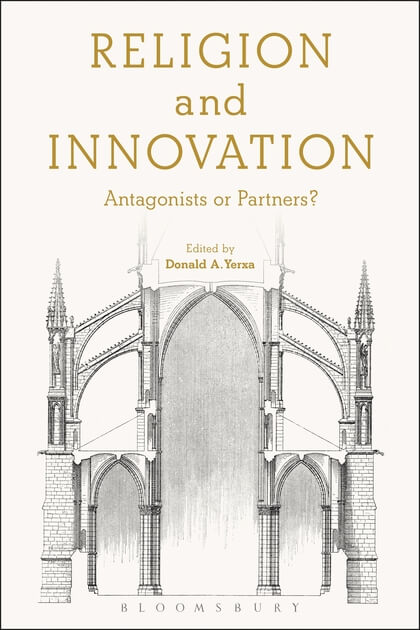Book Review: Religion and Innovation
Religion and Innovation:
Antagonists or Partners?
by Donald A. Yerxa
Review by Erica Bolin
This volume includes fourteen chapters written by different authors, each taking a critical look at the assumption that religion is necessarily opposed to innovation. Each of the essays takes a different perspective utilizing and benefiting from diverse academic disciplines such as archaeology, political science, history, economics, and architecture. The fundamental questions of what constitutes each of the larger realms under question—religion and innovation—are grappled with in almost every chapter. Each author uses his individual academic discipline of scholarship to add insight and shed a slightly different light on both the meaning and relationship of religion and innovation.
Chapters are grouped chronologically into three parts. Part 1 explores how innovation may have both been encouraged and hampered—ritually and political—among three different people groups in the Americas prior to the expeditions of Columbus. In Part 2, the interplay of innovation and religion is examined among Western cultures in several different time periods, starting with the 2nd Century Christian church and ending with modern day Europe and America. Finally, in Part 3, several topics relevant to the present and future are presented: how we deal with guilt when sin is no longer perceived as an issue in a secular society, a case study of women in India showing the impact of religious practices on their ability to overcome poverty, a study of the role of religion in the urban planning and architecture of Chicago, and a look at the underpinnings of a culture that sees technological innovation as the only way forward.
Part 1 delves into detailed archaeological research, but even if readers do not fully comprehend some of the more technical methods of the archeologists, it is possible to get a sense for their overall findings and implications. These early chapters are useful for broadening a sense of how “religion” and “innovation” are defined; they are not just activities of modern Western white people, but are, and long have been, fundamental to humanity.
The majority of the chapters in Part 2 describe historical situations and analyze their impacts. Science teachers will find chapters 5 and 6 by Peter Harrison to be particularly provocative. In chapter 5 he posits that there can be no simple causal relationship between religion and innovation, but suggests certain historical instances where links can be seen. In contrast to the prevailing secular rhetoric that claims religion plays only a conservative role in innovation, he offers the argument of sociologist Max Weber that the innovation of capitalism was actually undergirded by Protestant ideals. The following chapter includes several particular examples of a complex relationship between religion and scientific discovery with examples that call into question common assumptions. For example, he claims that the early Greek naturalists who were heralded for rejecting mystical explanations in favor of materialistic ones may not have rejected the supernatural so much as simply committing to a particular understanding of how the world is ordered. Other time periods the authors consider include the Dark Ages, the following centuries leading up to what we now call modern science, and the 19th century which elevated Naturalism and discounted any supernatural causes. These two chapters lay the groundwork for a discussion of how historical events and their interpretations shape our modern ways of thinking.
Part 3 looks toward the future while revisiting various discipline-specific topics. Chapter 11, “Sin, Guilt and the Future of Progress” by Wilfred M. McClay presents a compelling argument helpful to science teachers interested in encouraging students to understand our responsibility to care for the earth. McClay discusses the complications that arise when the concepts of sin and repentance are removed from secularized society, while at the same time mass communication makes information about all kinds of injustice readily available. This combination of extensive information without ethics of responsibility can have a crippling effect. This chapter is a valuable interdisciplinary discussion starter and gives voice to a feeling students may not be able to articulate on their own.
Religion and Innovation: Antagonists or Partners? offers an intriguing look at an complex topic. While some passages are dense and technical, and there are no specific or practical applications for the classroom, these essays provide much provocative material for conversations around faith and science.

